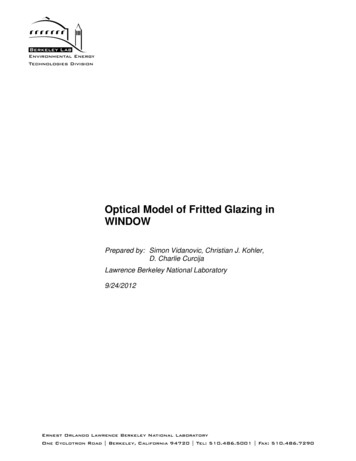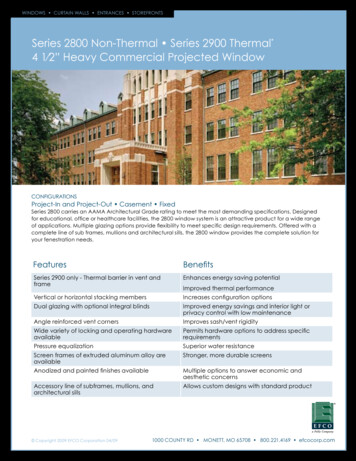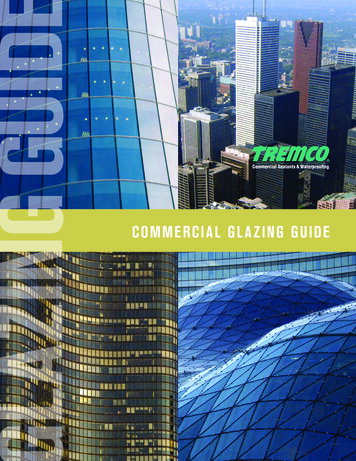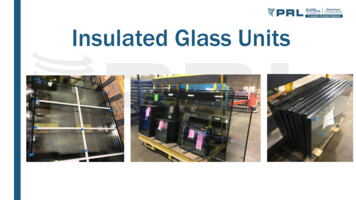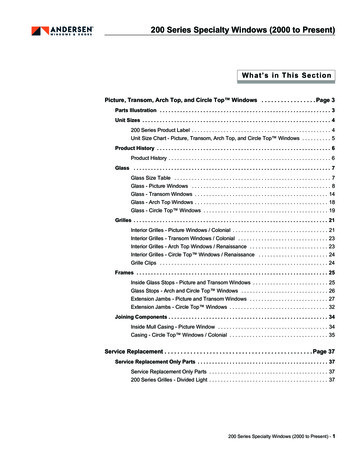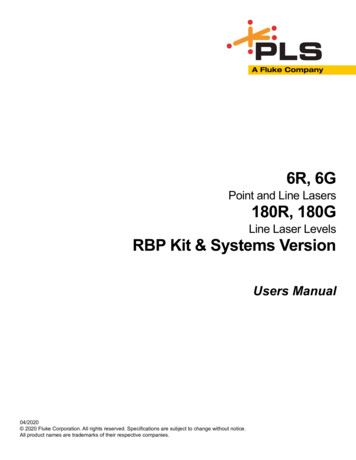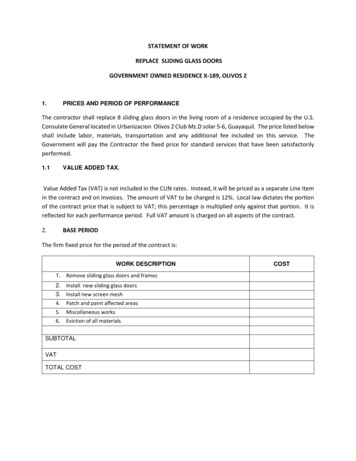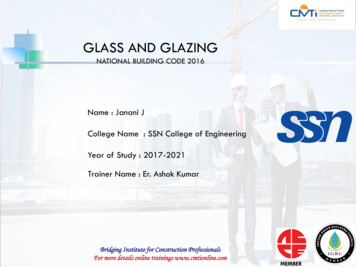
Transcription
GLASS AND GLAZINGNATIONAL BUILDING CODE 2016Name : Janani JCollege Name : SSN College of EngineeringYear of Study : 2017-2021Trainer Name : Er. Ashok KumarBridging Institute for Construction ProfessionalsFor more details online trainings www.cmtionline.comMEMBER
CONTENTS Introduction – Glass facadesTypes of architectural glassClassification of safety glass and its applicationsFire resistance glassBasis for glass selectionFactors affecting Solar Heat Gain and its reductionAnalysis for selection of glazingEnergy conservation through glazingReducing glare through glazingECBC RequirementsTest requirements for glazingSafety related to human impact as per NBC 2016Performance criteria for glazing systemConclusionReferencesBridging Institute for Construction ProfessionalsFor more details online trainings www.cmtionline.comMEMBER
WHAT ARE GLASS FACADES? The outer skin of the building made of glass is known as a glass facade. It is a non-structural element capable of sustaining its own weight. In very rare casesglass acts as a structurally load bearing member. Glasses are supported with Aluminum members called as Mullions and Transoms. Insome cases where the loading becomes higher, steel is also used as a supportingmember.Bridging Institute for Construction ProfessionalsFor more details online trainings www.cmtionline.comMEMBER
ITC KOHINOOR, HYDERABADRAJIV GANDHI INTERNATIONAL AIRPORT,HYDERABADBridging Institute for Construction ProfessionalsFor more details online trainings www.cmtionline.comMEMBER
IISER, CHENNAIASCENDAS INDIA PVT. LTD., PUNEBridging Institute for Construction ProfessionalsFor more details online trainings www.cmtionline.comMEMBER
ADVANTAGES OF GLASS FACADES Only envelope material which can give contact to the outside world forthe occupants of the building. Gives a pleasing architecture. Can accommodate thermal expansion and contraction and also thebuilding movements. Can accommodate water diversion, smoke seal, safety and security ofthe building. Does not required painting and hence the maintenance in lower.Bridging Institute for Construction ProfessionalsFor more details online trainings www.cmtionline.comMEMBER
DISADVANTAGES OF GLASS FACADES Glass absorbs heat. This means that it can act has a greenhouse and hence notsuitable for countries with hot climate. Most glasses are not earthquake resistance and not suitable for countries that witnessfrequent earthquakes. A very expensive kind of treatment given to glass can makethen earthquake resistant but such type of glass is not very affordable. Use of glass in a building may result in higher costs in making the building safe andsecure because glass results in lot of transparency. Glass, being an expensive material as compared to the other materials used in theconstruction industry, eventually augments the total cost of the building.Bridging Institute for Construction ProfessionalsFor more details online trainings www.cmtionline.comMEMBER
TYPES OF ARCHITECTURAL GLASS Base glass Clear glass Tinted glass Double glass unit Heat strengthened glass Safety glass Toughened safety glass Laminated safety glass Energy efficient glass Online coated glass (or) Chemical Vapour Deposition (CVD) Offline coated glass (Magnetron Sputtering)Bridging Institute for Construction ProfessionalsFor more details online trainings www.cmtionline.comMEMBER
CLASSIFICATION OF SAFETY GLASS Toughened Safety Glass : Processed by controlled thermal and chemical treatments toincrease its strength. It is 4 times more stronger than annealed glass. Laminated Safety Glass : Polyvinyl Butyl is used to hold two slices of glass together.Other types like Heat Strengthened Glass, Coated Glass can be part of LaminatedSafety Glass.Bridging Institute for Construction ProfessionalsFor more details online trainings www.cmtionline.comMEMBER
APPLICATIONS OF SAFETY GLASS Overhead glazing (Skylights) which are either horizontal or inclined. Sloping glass – used when there is a change in floor level and thereby poses a dangerof glass falling. Balustrades, floors and stairs – directly accessed by human and thereby directtransmission of loads to the glass.Critical locations of vulnerable human impact according to NBC 2016 In and around doors, low windows Door side panels Panels mistaken for doorway or opening Panels at low levels in walls and partitions Bathrooms Buildings associated with specific activities like gymnasia, enclosed swimming pool Schools and child care facilities Nursing homes and care facilities for the aged and infirmedBridging Institute for Construction ProfessionalsFor more details online trainings www.cmtionline.comMEMBER
TYPES OF FIRE RESISTANCE GLASS Wired glass : Not recommended for doors except as vision glass and there are sizerestrictions for windows Annealed fire resistance glass (AFG) : Not to be used in areas which require safetyagainst human impact Tempered fire resistance glass (TFG) : Dual property of withstanding both fire andhuman impactBridging Institute for Construction ProfessionalsFor more details online trainings www.cmtionline.comMEMBER
Intumescent laminated fire resistance glass (LFG) : Fire side of glass will break but ithas a gel between glasses to resist the fire from passing to the last glass layer for astipulated period of time, say 30 minutes, 60 minutes, 90 minutes, 120 minutes Double glazed fire resistant glass (DFG) : Both sides are resistant to human impactBridging Institute for Construction ProfessionalsFor more details online trainings www.cmtionline.comMEMBER
FIRE RESISTANCE – TYPE OF PRODUCTS Stability (E) : Resist fire and smoke without loss ofstructural stability. Integrity (EW) : Resist fire, smoke and thermalheat transfer that happens through glass. Insulation (EI) : Resistance to temperature rise onnon-fire side of glass.Bridging Institute for Construction ProfessionalsFor more details online trainings www.cmtionline.comMEMBER
KEY FACTORS ON FIRE RESISTANCE Entire glass assembly needs to be tested for fire resistance. Fire test certificate obtained for one application say, single door, double dooror partition wall, should not be used for any other applications. None of the linear dimensions of glass shall exceed that of glass that has beentested. Same hardware that is used for testing shall be used for execution. In case ofreplacement standard guidelines need to be followed. The dimensions of profile need to be same as tested. Factors like edge cover, type of gaskets and type of fixtures play a vital rolein fire performance must be used and installed as per test reports/availablestandards.Bridging Institute for Construction ProfessionalsFor more details online trainings www.cmtionline.comMEMBER
BASIS FOR GLAZING SELECTION Thickness of glazing is calculated subjected to wind load based on IS 875 Part 3where factors like Type of building Location of building Height of building Local wind impacts are considered For criteria on safety against human impact Critical location of glass Type of glass usedBridging Institute for Construction ProfessionalsFor more details online trainings www.cmtionline.comMEMBER
For criteria on optical, solar and thermal performance Visual Light Transmission : Percentage of light transmission that happens through theglass from outside environment to inside environment or from source to inside thebuilding. Solar Factor : Percentage of direct heat transfer that happens from outside environmentto inside environment. U Value : Heat transfer that happens through a building part such as wall or windowdue to difference in climatic conditions or temperature differences between outside andinside environment.Outside temperature – Inside temperature ΔtNormal clear glass has Visual Light Transmission of 89%, Solar Factor of 83-85% and UValue of 5.7Bridging Institute for Construction ProfessionalsFor more details online trainings www.cmtionline.comMEMBER
FACTORS INFLUENCING SOLAR HEAT GAIN Building orientation Glazed area : Window to wall ratioThey can be between 0% - 40% or 40% - 60% Shading devices – External & Internal Properties of the glazingBridging Institute for Construction ProfessionalsFor more details online trainings www.cmtionline.comMEMBER
HOW TO REDUCE SOLAR HEAT GAINTHROUGH GLAZING Reflective Coated Glass : Use of low emissivity coatings on glass Insulated Glass Units : Increasing width of air space by providing double glazing (outer glass is coated andinner glass is clear with 12mm air space between them) Use of inert gas in Insulated Glass Unit (IGU)Bridging Institute for Construction ProfessionalsFor more details online trainings www.cmtionline.comMEMBER
ANALYSIS FOR SELECTION OF GLAZING Building orientation analysisSun path analysisSite shadow analysisSolar exposure analysisDaylight analysisAcoustic analysisBridging Institute for Construction ProfessionalsFor more details online trainings www.cmtionline.comMEMBER
ENERGY CONSERVATION USING THE RIGHTGLASS AND GLAZING On controlling the thermal heat transfer through the glazing providedby using the right Solar Heat Gain Constant and U Value, we canreduce the cooling loads in buildings On utilizing the daylight by controlling the transmittance of lightthrough glass and adopting proper window to wall ratio, we canreduce the need and usage of artificial lightingBridging Institute for Construction ProfessionalsFor more details online trainings www.cmtionline.comMEMBER
REDUCING GLARE THROUGH GLAZINGGlare results from excessive contrast of illumination, or from an excess of illumination in thefield of view. Ways to reduce glare : Reduce Visual Light Transmission of the glazing to 60% Use of shading devices Re-orienting the glazing to avoid direct solar radiation Increasing illumination by means of more windows Reducing contrast between window and its surroundings Provision for allowing more daylight by daylight panes/light shelvesBridging Institute for Construction ProfessionalsFor more details online trainings www.cmtionline.comMEMBER
FENESTRATION DAYLIGHT REQUIREMENTS ASPER ECBCThe Energy Conservation Building Code (ECBC), was launched by Ministry of Power,Government of India in May 2007, as a first step towards promoting energy efficiencyin the building sector.Bridging Institute for Construction ProfessionalsFor more details online trainings www.cmtionline.comMEMBER
Bridging Institute for Construction ProfessionalsFor more details online trainings www.cmtionline.comMEMBER
TEST REQUIREMENTS FOR GLAZING Energy performance parameters to be tested on coated glass/IGU Tests for durabilityCondensation resistance : For coated glassAcid resistance/salt spray analysisAbrasion resistanceBridging Institute for Construction ProfessionalsFor more details online trainings www.cmtionline.comMEMBER
SAFETY RELATED TO HUMAN IMPACTAccording to NBC 2016, a safety glass is one that Does not break under most likely forms of human impact Even on breaking, the likelihood of cutting and piercing will be minimizedFurther the NBC 2016 does not deal with safety and security of people or goods inrelation to risks of Vandalism, riots, burglary or break in protection Fire arm protection Protection from explosion such as a terrorist attack Natural disasters Plastic glazing material, safety and security glazing, etc.Bridging Institute for Construction ProfessionalsFor more details online trainings www.cmtionline.comMEMBER
Bridging Institute for Construction ProfessionalsFor more details online trainings www.cmtionline.comMEMBER
TEST REQUIREMENTS FOR SAFETY GLASS ASPER NBC 2016Bridging Institute for Construction ProfessionalsFor more details online trainings www.cmtionline.comMEMBER
PERFORMANCE CRITERIA FOR GLAZING SYSTEM Design Parameters :Loading – Wind load, Dead load, Live load, Seismic load, load combinationsDeflection and allowable stresses for glass and frameMovements – Horizontal movements due to earthquakes, vertical movements due towind speed, thermal expansion and contraction, deflectionImpact resistanceResistance to fireAcoustics and sound insulationEnergy performanceStructural stability and safetyVisual comfortAir infiltrationWater penetrationBridging Institute for Construction ProfessionalsFor more details online trainings www.cmtionline.comMEMBER
CONCLUSIONGlass and glazing systems play a vital role in buildings. Their use in buildings hasincreased manifolds in the recent times. Glass facades not only provide an aestheticallyappealing view to a building and psychologically and physiologically increasing the wellbeing of the occupants but also conserving energy used by the building.The inclusion of ‘Glass and Glazing’ in the Part 6 Structural Design Section 8 of theNational Building Code 2016 is indeed useful in the selection of type of glazingrequired considering key factors like building location, orientation and height, type ofapplication of the glass, the properties of the glass etc.India is a fast growing nation and over 100 airports use glass facades for theirterminals. As a civil engineer, the knowledge on glass and glazing and its design is vital.There is a lot of scope for façade engineers in the current scenario.Bridging Institute for Construction ProfessionalsFor more details online trainings www.cmtionline.comMEMBER
REFERENCES National Building Code 2016 NPTEL Videos Study Materials from CMTI CMTI Connect - YouTube VideosBridging Institute for Construction ProfessionalsFor more details online trainings www.cmtionline.comMEMBER
Bridging Institute for Construction ProfessionalsFor more details online trainings www.cmtionline.comMEMBER
The inclusion of 'Glass and Glazing'in the Part 6 Structural Design Section 8 of the National Building Code 2016 is indeed useful in the selection of type of glazing required considering key factors like building location, orientation and height, type of application of the glass, the properties of the glass etc.

